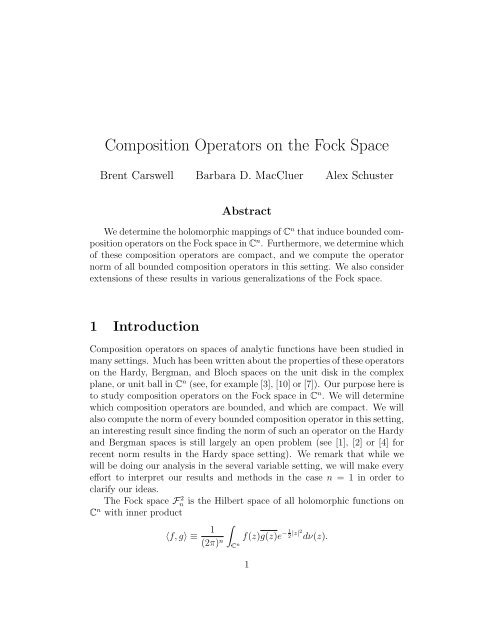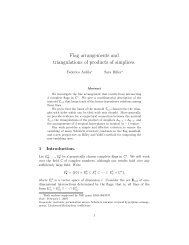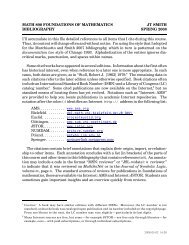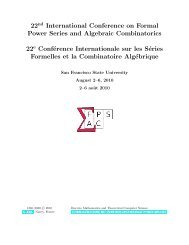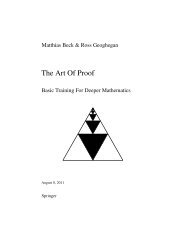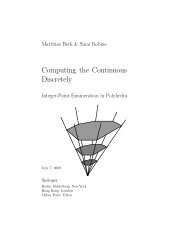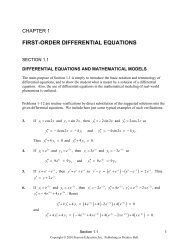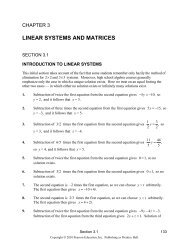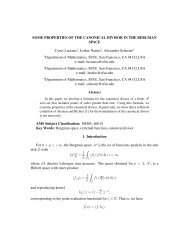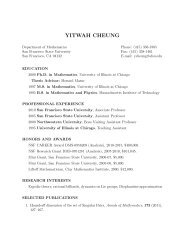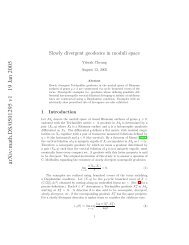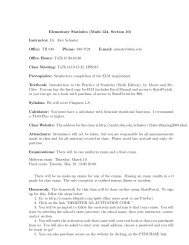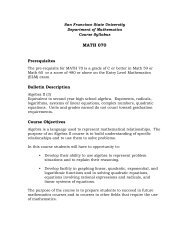Composition Operators on the Fock Space - Mathematics - San ...
Composition Operators on the Fock Space - Mathematics - San ...
Composition Operators on the Fock Space - Mathematics - San ...
Create successful ePaper yourself
Turn your PDF publications into a flip-book with our unique Google optimized e-Paper software.
<str<strong>on</strong>g>Compositi<strong>on</strong></str<strong>on</strong>g> <str<strong>on</strong>g>Operators</str<strong>on</strong>g> <strong>on</strong> <strong>the</strong> <strong>Fock</strong> <strong>Space</strong><br />
Brent Carswell Barbara D. MacCluer Alex Schuster<br />
Abstract<br />
We determine <strong>the</strong> holomorphic mappings of C n that induce bounded compositi<strong>on</strong><br />
operators <strong>on</strong> <strong>the</strong> <strong>Fock</strong> space in C n . Fur<strong>the</strong>rmore, we determine which<br />
of <strong>the</strong>se compositi<strong>on</strong> operators are compact, and we compute <strong>the</strong> operator<br />
norm of all bounded compositi<strong>on</strong> operators in this setting. We also c<strong>on</strong>sider<br />
extensi<strong>on</strong>s of <strong>the</strong>se results in various generalizati<strong>on</strong>s of <strong>the</strong> <strong>Fock</strong> space.<br />
1 Introducti<strong>on</strong><br />
<str<strong>on</strong>g>Compositi<strong>on</strong></str<strong>on</strong>g> operators <strong>on</strong> spaces of analytic functi<strong>on</strong>s have been studied in<br />
many settings. Much has been written about <strong>the</strong> properties of <strong>the</strong>se operators<br />
<strong>on</strong> <strong>the</strong> Hardy, Bergman, and Bloch spaces <strong>on</strong> <strong>the</strong> unit disk in <strong>the</strong> complex<br />
plane, or unit ball in Cn (see, for example [3], [10] or [7]). Our purpose here is<br />
to study compositi<strong>on</strong> operators <strong>on</strong> <strong>the</strong> <strong>Fock</strong> space in Cn . We will determine<br />
which compositi<strong>on</strong> operators are bounded, and which are compact. We will<br />
also compute <strong>the</strong> norm of every bounded compositi<strong>on</strong> operator in this setting,<br />
an interesting result since finding <strong>the</strong> norm of such an operator <strong>on</strong> <strong>the</strong> Hardy<br />
and Bergman spaces is still largely an open problem (see [1], [2] or [4] for<br />
recent norm results in <strong>the</strong> Hardy space setting). We remark that while we<br />
will be doing our analysis in <strong>the</strong> several variable setting, we will make every<br />
effort to interpret our results and methods in <strong>the</strong> case n = 1 in order to<br />
clarify our ideas.<br />
The <strong>Fock</strong> space F 2 n is <strong>the</strong> Hilbert space of all holomorphic functi<strong>on</strong>s <strong>on</strong><br />
Cn with inner product<br />
〈f, g〉 ≡ 1<br />
(2π) n<br />
<br />
n<br />
1<br />
−<br />
f(z)g(z)e 2 |z|2<br />
dν(z).<br />
1
Here ν denotes Lebesgue measure <strong>on</strong> C n . To simplify notati<strong>on</strong> we will often<br />
use F instead of F 2 n, and we will denote by f <strong>the</strong> norm of f.<br />
The reproducing kernel functi<strong>on</strong>s for <strong>the</strong> <strong>Fock</strong> space are given by<br />
kw(z) = e 〈z,w〉/2 ,<br />
where 〈z, w〉 = n<br />
1 zjwj. Note that <strong>the</strong> substituti<strong>on</strong> f = kw into <strong>the</strong> reproducing<br />
formula 〈f, kw〉 = f(w), which holds for all f ∈ F and w ∈ C n , leads<br />
to <strong>the</strong> identity kw = exp(|w| 2 /4).<br />
For a given holomorphic mapping ϕ : C n → C n , <strong>the</strong> compositi<strong>on</strong> operator<br />
Cϕ : F → F is given by Cϕ(f) = f ◦ϕ. Our first main result (see Theorem 1)<br />
will show that if <strong>the</strong> operator Cϕ is bounded, <strong>the</strong>n ϕ must be of <strong>the</strong> form<br />
ϕ(z) = Az + B, where A is an n × n matrix and B is an n × 1 vector.<br />
Fur<strong>the</strong>rmore, it will follow that A ≤ 1 for bounded Cϕ, and that B will be<br />
restricted by <strong>the</strong> c<strong>on</strong>diti<strong>on</strong> that 〈Aζ, B〉 = 0 for any ζ in C n with |Aζ| = |ζ|.<br />
Theorem 1 will also show that if Cϕ is compact, <strong>the</strong>n A < 1 with no<br />
restricti<strong>on</strong> <strong>on</strong> B. Our sec<strong>on</strong>d result will be Theorem 2, which gives <strong>the</strong><br />
c<strong>on</strong>verse to Theorem 1. In our third main result, Theorem 4, we determine<br />
<strong>the</strong> operator norm of Cϕ (where ϕ(z) = Az + B is chosen so that Cϕ is<br />
bounded) in terms of A and B. Finally, in <strong>the</strong> last secti<strong>on</strong>, we will outline<br />
some ideas about how to extend our results to various generalizati<strong>on</strong>s of <strong>the</strong><br />
<strong>Fock</strong> space.<br />
We thank Christopher Hamm<strong>on</strong>d for several helpful remarks <strong>on</strong> <strong>the</strong> proof<br />
of Theorem 4.<br />
2 Main results<br />
Our first result c<strong>on</strong>cerns <strong>the</strong> boundedness and compactness of compositi<strong>on</strong><br />
operators <strong>on</strong> F.<br />
Theorem 1. Suppose ϕ : C n → C n is a holomorphic mapping.<br />
(a) If Cϕ is bounded <strong>on</strong> F, <strong>the</strong>n ϕ(z) = Az +B, where A is an n×n matrix<br />
and B is an n × 1 vector. Fur<strong>the</strong>rmore, A ≤ 1, and if |Aζ| = |ζ| for<br />
some ζ in C n , <strong>the</strong>n 〈Aζ, B〉 = 0.<br />
(b) If Cϕ is compact <strong>on</strong> F, <strong>the</strong>n ϕ(z) = Az + B, where A < 1.<br />
2
Note that when n = 1, Theorem 1(a) simply says that if Cϕ is bounded<br />
<strong>on</strong> F, <strong>the</strong>n ϕ(z) = az + b, where |a| ≤ 1, and if |a| = 1, <strong>the</strong>n b = 0.<br />
In <strong>the</strong> proof of Theorem 1 we will use <strong>the</strong> fact that every entire functi<strong>on</strong><br />
<strong>on</strong> Cn has a multi-index power series expansi<strong>on</strong> of <strong>the</strong> form <br />
α c(α)zα , where<br />
α denotes a multi-index (α1, α2, · · · , αn) of n<strong>on</strong>-negative integers, and z α =<br />
z α1<br />
1 z α2<br />
2 · · · z αn<br />
n . We use <strong>the</strong> standard notati<strong>on</strong> |α| = α1 + · · · + αn and α! =<br />
α1! · · · αn!. The quantity |α| is referred to as <strong>the</strong> total order of <strong>the</strong> multi-index<br />
α.<br />
Proof of Theorem 1. If Cϕ is bounded <strong>on</strong> F, <strong>the</strong>n<br />
sup<br />
w∈n C∗ ϕ(kw)<br />
kw<br />
= sup<br />
w∈n kϕ(w)<br />
kw<br />
= sup<br />
w∈n <br />
1 2 2<br />
exp |ϕ(w)| − |w|<br />
4<br />
<br />
< ∞, (1)<br />
where <strong>the</strong> first equality follows from <strong>the</strong> easily verified property C ∗ ϕ(kw) =<br />
kϕ(w). From (1) it follows that<br />
lim sup<br />
|w|→∞<br />
|ϕ(w)|<br />
|w|<br />
≤ 1. (2)<br />
For each ζ ∈ ∂Bn and 1 ≤ j ≤ n, we define <strong>the</strong> analytic functi<strong>on</strong> ϕ j<br />
ζ by <strong>the</strong><br />
equati<strong>on</strong> ϕ j<br />
ζ (λ) = ϕj(λζ) for λ ∈ C, where ϕj is <strong>the</strong> jth coordinate functi<strong>on</strong><br />
of ϕ. By (2) we must have<br />
lim sup<br />
|λ|→∞<br />
|ϕ j<br />
ζ (λ)|<br />
|λ|<br />
≤ 1.<br />
If ϕj(z) = <br />
α c(α)zα has homogeneous expansi<strong>on</strong> ∞ s=0 Fs(z) (defined by<br />
Fs(z) = <br />
|α|=s c(α)zα ), <strong>the</strong>n since ϕ j<br />
ζ (λ) = λsFs(ζ), we must have Fs(ζ) =<br />
0 for all s ≥ 2 and ζ ∈ ∂Bn; that is Fs ≡ 0 for s ≥ 2 and each coordinate<br />
functi<strong>on</strong> ϕj is linear. This proves that ϕ(z) = Az+B as desired. If |Aζ| > |ζ|<br />
for some ζ of norm 1, <strong>the</strong>n setting w = tζ, t > 0 in (2) and letting t → ∞ we<br />
obtain a c<strong>on</strong>tradicti<strong>on</strong>. Thus we must have A ≤ 1.<br />
Next we show that if |Aζ| = |ζ|, <strong>the</strong>n 〈Aζ, B〉 = 0. As a special case<br />
of this, suppose Aζ = λζ where λ is a complex number of modulus 1. If<br />
〈Aζ, B〉 = 0, we may choose ρ ∈ C, |ρ| = 1 so that ρ〈Aζ, B〉 > 0. C<strong>on</strong>sidering<br />
w = tρζ as t → ∞, we obtain a c<strong>on</strong>tradicti<strong>on</strong> to (1). Now suppose Aζ = η,<br />
where |ζ| = |η| = 1. Let U be a unitary map of Cn such that Uη = ζ. Then<br />
for τ(z) ≡ ϕ ◦ U(z) = A ◦ U(z) + B, we have Cτ bounded <strong>on</strong> F and, since<br />
3
A(U(η)) = η, by <strong>the</strong> special case just c<strong>on</strong>sidered, we have 〈AUη, B〉 = 0 or<br />
〈Aζ, B〉 = 0 as desired. This completes <strong>the</strong> proof of (a).<br />
To prove (b) we need <strong>on</strong>ly show that if ϕ(z) = Az + B induces a compact<br />
compositi<strong>on</strong> operator <strong>on</strong> F, <strong>the</strong>n A < 1. Since <strong>the</strong> normalized reproducing<br />
kernel functi<strong>on</strong>s kw/kw tend to 0 weakly as |w| → ∞, we have<br />
<br />
1<br />
Cϕe ≥ lim sup exp<br />
|w|→∞ 4 (|ϕ(w)|2 − |w| 2 <br />
) ,<br />
where for an operator T , T e = inf{T −Q : Q is compact} is <strong>the</strong> essential<br />
norm of T . (c.f. Propositi<strong>on</strong> 3.13 in [3] for <strong>the</strong> proof of a similar fact in<br />
o<strong>the</strong>r spaces). Now suppose that A = 1 and that ζ = 0 satisfies |Aζ| = |ζ|.<br />
Let w = λζ, where λ ∈ C and λ〈Aζ, B〉 ≥ 0. Letting |λ| → ∞, we see that<br />
Cϕe = 0, and so A is not compact. Thus A < 1.<br />
The c<strong>on</strong>verse to Theorem 1 holds as well.<br />
Theorem 2. Suppose ϕ(z) = Az + B, where A is an n × n matrix with<br />
A ≤ 1, and B is an n × 1 vector.<br />
(a) If 〈Aζ, B〉 = 0 whenever |Aζ| = |ζ|, <strong>the</strong>n Cϕ is bounded <strong>on</strong> F.<br />
(b) If A < 1, <strong>the</strong>n Cϕ is compact <strong>on</strong> F.<br />
Before we give <strong>the</strong> proof of this <strong>the</strong>orem, we need several preliminary<br />
results that will be of use throughout <strong>the</strong> rest of this secti<strong>on</strong>. First we recall<br />
<strong>the</strong> noti<strong>on</strong> of <strong>the</strong> singular value decompositi<strong>on</strong> of an n × n matrix.<br />
Theorem 3. If A is an n × n matrix of rank k, <strong>the</strong>n A can be written as<br />
A = V ΣW , where V, W are n × n unitary matrices, and Σ is a diag<strong>on</strong>al<br />
matrix (σij) with σ11 ≥ σ22 ≥ · · · ≥ σkk > σk+1,k+1 = · · · = σnn = 0. The<br />
σii are <strong>the</strong> n<strong>on</strong>-negative square roots of <strong>the</strong> eigenvalues of AA ∗ ; if we require<br />
that <strong>the</strong>y be listed in decreasing order, <strong>the</strong>n Σ is uniquely determined from A.<br />
A proof can be found in [6]. For brevity of notati<strong>on</strong> we will write σi for<br />
σii, <strong>the</strong> i th diag<strong>on</strong>al entry of Σ.<br />
Note that if A ≤ 1, <strong>the</strong>n <strong>the</strong> σi will all be less than or equal to 1, and<br />
at least <strong>on</strong>e will equal 1 if A = 1. We make two notati<strong>on</strong>al definiti<strong>on</strong>s that<br />
will be in force for <strong>the</strong> rest of this secti<strong>on</strong>. Set<br />
j = max{r : σr = 1}, (3)<br />
4
(where j = 0 in <strong>the</strong> case that no σr = 1), and<br />
k = max{r : σr > 0}, (4)<br />
so that k = rank A.<br />
The singular value decompositi<strong>on</strong> will allow us to perform a useful normalizati<strong>on</strong><br />
in proving Theorem 2. This normalizati<strong>on</strong> will also play a role<br />
later in this secti<strong>on</strong> when we compute <strong>the</strong> norm of Cϕ <strong>on</strong> F. We remark<br />
that in <strong>the</strong> <strong>on</strong>e variable setting this normalizati<strong>on</strong> is not needed, though its<br />
presence <strong>the</strong>re does no harm.<br />
Propositi<strong>on</strong> 1. Suppose ϕ(z) = Az +B, where A and B are as described in<br />
(a) of Theorem 1. Let ψ(z) = Σz+B ′ , where <strong>the</strong> singular value decompositi<strong>on</strong><br />
of A is V ΣW , and B ′ = V ∗ B. Then <strong>on</strong> F, Cϕ = CW CψCV , where CW and<br />
CV are <strong>the</strong> unitary operators given by CW (f) = f ◦ W and CV (f) = f ◦ V .<br />
Proof. We have<br />
CW CψCV (f)(z) = (f ◦ V ◦ ψ ◦ W )(z) = f(V ΣW (z) + V B ′ )<br />
= f(Az + B) = Cϕ(f)(z)<br />
as desired, where we have used <strong>the</strong> relati<strong>on</strong>ship V B ′ = B.<br />
Corollary 1. The operator Cϕ is bounded (resp., compact) <strong>on</strong> F if and <strong>on</strong>ly<br />
if Cψ is bounded (resp., compact) <strong>on</strong> F. Moreover, <strong>the</strong> norm of Cϕ is equal<br />
to <strong>the</strong> norm of Cψ.<br />
If ϕ(z) = Az + B and ψ(z) = Σz + B ′ , where Σ and B ′ are as given in<br />
Propositi<strong>on</strong> 1, we call ψ a normalizati<strong>on</strong> of ϕ. The following lemma gives<br />
<strong>the</strong> reformulati<strong>on</strong> of <strong>the</strong> hypo<strong>the</strong>sis “〈Aζ, B〉 = 0 whenever |Aζ| = |ζ|” from<br />
Theorem 2 as applied to <strong>the</strong> normalizati<strong>on</strong> ψ.<br />
Lemma 1. Suppose that ϕ(z) = Az + B satisfies <strong>the</strong> hypo<strong>the</strong>sis of (a) of<br />
Theorem 2, and suppose ψ = Σz + B ′ is a normalizati<strong>on</strong> of ϕ. Then <strong>the</strong> first<br />
j coordinates of B ′ are 0.<br />
Proof. Let A have singular value decompositi<strong>on</strong> A = V ΣW as in Theorem 3.<br />
Since |Aζ| = |ζ| implies 〈Aζ, B〉 = 0, we have<br />
0 = 〈ΣW ζ, V ∗ B〉 = 〈ΣW ζ, B ′ 〉 (5)<br />
5
whenever |Aζ| = |ζ|. If ζ is chosen so that W ζ = (0, · · · , 1, · · · , 0) t (where <strong>the</strong><br />
1 appears in <strong>the</strong> m th positi<strong>on</strong>, 1 ≤ m ≤ j), <strong>the</strong>n |Aζ| = |ζ| and ΣW ζ = W ζ,<br />
so that (5) implies that <strong>the</strong> m th coordinate of B ′ is 0.<br />
Proof of Theorem 2. By Corollary 1 and <strong>the</strong> remarks following it, to<br />
prove (a) we need <strong>on</strong>ly show that if ψ(z) = Σz + B ′ , where Σ is as described<br />
in Propositi<strong>on</strong> 1 and <strong>the</strong> first j coordinates of B ′ are 0 (where j is defined<br />
by (3)), <strong>the</strong>n Cψ is bounded <strong>on</strong> F. If Σ is invertible, this will follow from a<br />
change of variables argument. We have<br />
<br />
|f ◦ ψ(z)| 2 1<br />
−<br />
e 2 |z|2<br />
<br />
dν(z) = c |f(w)| 2 exp<br />
n<br />
= c ′<br />
<br />
n<br />
n<br />
<br />
− 1<br />
<br />
<br />
<br />
−1 ′<br />
Σ (w − B ) 2<br />
| dν<br />
2<br />
|f(w)| 2 <br />
exp − 1<br />
2 (|Σ−1w| 2 − |w| 2 − 2Re〈Σ −1 w, Σ −1 B ′ 〉)<br />
<br />
1<br />
−<br />
e 2 |w|2<br />
dν<br />
where c = (det Σ) −2 and c ′ = c exp(−|Σ −1 B ′ | 2 /2). It suffices to show that<br />
|Σ −1 w| 2 − |w| 2 − 2Re〈Σ −1 w, Σ −1 B ′ 〉 (6)<br />
is bounded away from −∞ as w ranges over C n . By Lemma 1 we see that<br />
<strong>the</strong> expressi<strong>on</strong> in (6) attains its minimum at points w ∈ C n satisfying<br />
|wm| = |b′ m|<br />
1 − σ 2 m<br />
and wmb ′ m ≥ 0<br />
for j + 1 ≤ m ≤ n. This gives <strong>the</strong> desired result.<br />
If Σ is not invertible, <strong>the</strong>n we have σm = 0 for k < m ≤ n, where k is<br />
as defined in (4). Let Σ1 = Σ and Σ2 be <strong>the</strong> diag<strong>on</strong>al matrix with Σ1 = Σ2<br />
except in <strong>the</strong> last n − k positi<strong>on</strong>s al<strong>on</strong>g <strong>the</strong> diag<strong>on</strong>al, where Σ1 has entries<br />
equal to 0 and Σ2 has entries equal to 1<br />
2<br />
. By <strong>the</strong> argument just finished for<br />
<strong>the</strong> invertible case, Cψ2 is bounded <strong>on</strong> F, where ψ2(z) = Σ2z + B ′ . Thus if<br />
f = c(α)z α is in F, so is f ◦ ψ2. Notice we can write f ◦ ψ2 as g + h, where<br />
g is<br />
<br />
α<br />
c(α)z α1<br />
1 · · · z αj<br />
j (σj+1zj+1 + b ′ j+1) αj+1 · · · (σkzk + b ′ k) αk (b ′ k+1) αk+1 · · · (b ′ n) αn<br />
and h = f ◦ ψ2 − g. The terms of h involve at least <strong>on</strong>e of <strong>the</strong> variables<br />
zk+1, · · · , zn, but <strong>the</strong> terms of g do not. The orthog<strong>on</strong>ality of <strong>the</strong> m<strong>on</strong>omials<br />
6
in F <strong>the</strong>n implies that f ◦ ψ2 ≥ g. But g = f ◦ ψ, and so f ◦ ψ ∈ F. By<br />
<strong>the</strong> closed graph <strong>the</strong>orem we c<strong>on</strong>clude that Cψ is bounded <strong>on</strong> F.<br />
Finally we prove (b). Again first suppose that Σ is invertible. To show<br />
Cψ is compact, it suffices to show that a sequence {fn} that is bounded in F<br />
and c<strong>on</strong>verges to 0 uniformly <strong>on</strong> compact subsets of C n has its image under<br />
Cψ c<strong>on</strong>verge to 0 in norm. Changing variables as above, we have<br />
fn ◦ ψ 2 <br />
= c<br />
n |fn(w)| 2 1<br />
−<br />
e 2 |Σ−1w−Σ−1B ′ | 2<br />
e 1<br />
2 |w|2<br />
1<br />
−<br />
e 2 |w|2<br />
dν(w).<br />
Since σi < 1 for all 1 ≤ i ≤ n, a calculati<strong>on</strong> shows that<br />
1<br />
−<br />
e 2 |Σ−1w−Σ−1B ′ | 2<br />
e 1<br />
2 |w|2<br />
is as small as desired off a compact subset of C n . Since fn c<strong>on</strong>verges to<br />
0 uniformly <strong>on</strong> compact sets, and fn is bounded, this guarantees that<br />
fn ◦ ψ → 0. In <strong>the</strong> case Σ is not invertible, we again compare Cψ to Cψ2,<br />
as defined above. Then fn ◦ ψ → 0, since fn ◦ ψ2 → 0 and fn ◦ ψ2 ≥<br />
fn ◦ ψ.<br />
We turn now to <strong>the</strong> issue of norm calculati<strong>on</strong>s.<br />
Theorem 4. Suppose ϕ(z) = Az + B, where ei<strong>the</strong>r A < 1 and B is<br />
arbitrary, or A = 1 and 〈Aζ, B〉 = 0 whenever |Aζ| = |ζ|. Then <strong>on</strong> F we<br />
have<br />
<br />
1 <br />
Cϕ = exp |w0|<br />
4<br />
2 − |Aw0| 2 + |B| 2<br />
, (7)<br />
where w0 is any soluti<strong>on</strong> to (I − A ∗ A)w = A ∗ B.<br />
Before turning to <strong>the</strong> proof of Theorem 4, we make several remarks. First<br />
note that Theorem 4 is trivial in <strong>the</strong> case that A is unitary, so henceforth we<br />
will assume A is not unitary.<br />
Next note that in <strong>on</strong>e variable, <strong>the</strong> equati<strong>on</strong> (1 − aa)w = ab has <strong>the</strong><br />
unique soluti<strong>on</strong> w = ab/(1 − |a| 2 ) if |a| < 1, so that<br />
<br />
1 |b|<br />
Cϕ = exp<br />
4<br />
2<br />
1 − |a| 2<br />
<br />
.<br />
7
In several variables it is natural to ask whe<strong>the</strong>r <strong>the</strong> equati<strong>on</strong> (I−A ∗ A)w =<br />
A ∗ B always has a soluti<strong>on</strong> under our hypo<strong>the</strong>sis <strong>on</strong> ϕ, and if so, whe<strong>the</strong>r <strong>the</strong><br />
soluti<strong>on</strong> uniquely determines <strong>the</strong> expressi<strong>on</strong> in (7). Indeed, since A ∗ B is<br />
orthog<strong>on</strong>al to <strong>the</strong> kernel of I − A ∗ A, a soluti<strong>on</strong> will always exist. To verify<br />
that <strong>the</strong> expressi<strong>on</strong> given in Equati<strong>on</strong> 7 is c<strong>on</strong>stant <strong>on</strong> <strong>the</strong> soluti<strong>on</strong> set of<br />
(I − A ∗ A)w = A ∗ B, note that if<br />
(I − A ∗ A)w0 = A ∗ B = (I − A ∗ A)w1<br />
<strong>the</strong>n w0 − w1 ∈ ker (I − A ∗ A), and thus 〈w0 − w1, A ∗ B〉 = 0, so that<br />
|w0| 2 −|Aw0| 2 = 〈w0, w0−A ∗ Aw0〉 = 〈w0, A ∗ B〉 = 〈w1, A ∗ B〉 = |w1| 2 −|Aw1| 2 .<br />
In order to prove Theorem 4, we will use a normalizati<strong>on</strong> of ϕ as we<br />
did in <strong>the</strong> proof of Theorem 2. Indeed, let ψ = Σz + B ′ where Σ =<br />
diag {σi} with σ1 = · · · = σj = 1 and σj+1, · · · , σn < 1, and with B ′ =<br />
(0, · · · , 0, b ′ j+1, · · · , b ′ n) t . We first observe that if (I − A ∗ A)w0 = A ∗ B and<br />
(I − Σ ∗ Σ)w = Σ ∗ B ′ , <strong>the</strong>n<br />
|w0| 2 − |Aw0| 2 + |B| 2 = |w| 2 − |Σw| 2 + |B ′ | 2 .<br />
This, toge<strong>the</strong>r with <strong>the</strong> fact that Cϕ = Cψ, implies that in order to prove<br />
Theorem 4 it suffices to prove it for <strong>the</strong> normalizati<strong>on</strong> ψ(z) = Σz + B ′ .<br />
We next observe that soluti<strong>on</strong>s to (I − Σ ∗ Σ)w = Σ ∗ B ′ are easily seen to<br />
be<br />
wm =<br />
Fur<strong>the</strong>rmore, for such w we have<br />
σmb ′ m/(1 − σ 2 m) for m ≥ j + 1<br />
arbitrary for m ≤ j.<br />
|w| 2 − |Σw| 2 + |B ′ | 2 =<br />
n<br />
m=j+1<br />
|b ′ m| 2<br />
1 − σ2 .<br />
m<br />
This implies that in order to prove Theorem 4 we need <strong>on</strong>ly show that<br />
′<br />
1 |b j+1|<br />
Cψ = exp<br />
4<br />
2<br />
1 − σ2 j+1<br />
+ · · · + |b′ n| 2<br />
1 − σ2 <br />
,<br />
n<br />
(8)<br />
which we will turn to shortly.<br />
The proof of Theorem 4 will require a representati<strong>on</strong> for <strong>the</strong> adjoint of<br />
Cϕ, which we obtain in <strong>the</strong> following result.<br />
8
Lemma 2. If ϕ(z) = Az + B where A, B satisfy <strong>the</strong> hypo<strong>the</strong>sis of Theorem<br />
1(a), so that Cϕ is bounded <strong>on</strong> F, <strong>the</strong>n C∗ ϕ = MkBCτ, where τ(z) = A∗z and<br />
is multiplicati<strong>on</strong> by <strong>the</strong> kernel functi<strong>on</strong> kB.<br />
MkB<br />
Proof. The proof follows by checking that C ∗ ϕ(kw) = exp(〈z, Aw + B〉/2) =<br />
MkB Cτ(kw) for all w ∈ C n . Since <strong>the</strong> span of <strong>the</strong> kernel functi<strong>on</strong>s is dense in<br />
F, <strong>the</strong> result follows.<br />
The next result gives a lower bound for Cψ, where ψ is a normalizati<strong>on</strong><br />
of ϕ.<br />
Lemma 3. Suppose ϕ(z) = Az + B satisfies <strong>the</strong> hypo<strong>the</strong>sis of Theorem 4<br />
and let ψ be a normalizati<strong>on</strong>. We have<br />
Cψ ≥ sup<br />
w∈n C∗ ψ (kw)<br />
′<br />
1 |b j+1|<br />
= exp<br />
kw 4<br />
2<br />
1 − σ2 + · · · +<br />
j+1<br />
|b′ n| 2<br />
1 − σ2 <br />
.<br />
n<br />
Proof. We have<br />
C∗ 2<br />
ψ (kw)<br />
kw2 2<br />
kψ(w) 1 2 2<br />
= = exp |ψ(w)| − |w|<br />
kw2 2<br />
<br />
.<br />
Since Σ = diag(σi) with σi = 1 for i ≤ j, where j defined is as in Equati<strong>on</strong> 3,<br />
it is easy to check that |ψ(w)| 2 − |w| 2 attains its maximum at points w ∈ C n<br />
which satisfy, for j + 1 ≤ m ≤ n,<br />
and<br />
|wm| = σm|b ′ m|<br />
1 − σ 2 m<br />
arg wm chosen so that wmb ′ m ≥ 0.<br />
Hence <strong>the</strong> maximum value of |ψ(w)| 2 − |w| 2 is <strong>the</strong>n<br />
|B ′ | 2 +<br />
This gives <strong>the</strong> desired result.<br />
n<br />
m=j+1<br />
σ 2 m|b ′ m| 2<br />
1 − σ 2 m<br />
=<br />
n<br />
m=j+1<br />
|b ′ m| 2<br />
1 − σ2 .<br />
m<br />
For <strong>the</strong>se normalized maps ψ we will compute Cψ by identifying a<br />
reducing subspace M for Cψ and computing Cψ|M and Cψ|N, where N<br />
is <strong>the</strong> orthog<strong>on</strong>al complement of M. The next lemma identifies this subspace<br />
M.<br />
9
Lemma 4. Let ψ(z) = Σz + B ′ be a normalizati<strong>on</strong> of ϕ, where ϕ satisfies<br />
<strong>the</strong> hypo<strong>the</strong>sis of Theorem 4. Define j, possibly 0, by Equati<strong>on</strong> (3). Let<br />
M = {f ∈ F : f depends <strong>on</strong> zj+1, zj+2, · · · , zn <strong>on</strong>ly}.<br />
Then M is a reducing subspace for Cψ and <strong>the</strong> restricti<strong>on</strong> of Cψ to M is<br />
compact.<br />
Proof. If f is in M, <strong>the</strong>n <strong>the</strong> power series expansi<strong>on</strong> of f about 0 has<br />
<strong>the</strong> form c(α)zα where <strong>the</strong> sum is over multi-indices α = (α1, · · · , αn)<br />
satisfying α1 = · · · = αj = 0. That Cψ(M) ⊂ M is <strong>the</strong>n immediate from <strong>the</strong><br />
form of Σ.<br />
To see that C∗ ψ (M) ⊂ M, let f ∈ M and use Lemma 2 to write<br />
C ∗ ψ(f)(z) = kB ′(z)f(Σz) = exp(〈z, B′ 〉/2)f(Σz).<br />
Since <strong>the</strong> first j coordinates of B ′ are 0, this is a functi<strong>on</strong> in M. Thus M is<br />
a reducing subspace for Cψ.<br />
To see that Cψ restricted to M is compact, c<strong>on</strong>sider <strong>the</strong> map ˜ ψ obtained<br />
from ψ by replacing any 1 ′ s al<strong>on</strong>g <strong>the</strong> diag<strong>on</strong>al of Σ by 1/2 ′ s. By Theorem<br />
2(b), C ˜ ψ is compact <strong>on</strong> F. Since Cψ and C ˜ ψ agree <strong>on</strong> <strong>the</strong> subspace M,<br />
and <strong>the</strong> restricti<strong>on</strong> of a compact operator to a closed subspace is compact,<br />
<strong>the</strong> result follows.<br />
Corollary 2. Let ψ and M be as in Lemma 4. Then<br />
<br />
1<br />
Cψ|M ≥ exp<br />
4<br />
n |b ′ m| 2<br />
1 − σ2 <br />
.<br />
m<br />
Proof. When w ∈ C N satisfies<br />
and<br />
m=j+1<br />
wm = 0 for 1 ≤ m ≤ j<br />
|wm| = σm|b ′ m|<br />
1 − σ 2 m<br />
for j + 1 ≤ m ≤ n<br />
wmb ′ m ≥ 0<br />
10
<strong>the</strong>n kw ∈ M, and by <strong>the</strong> calculati<strong>on</strong>s in <strong>the</strong> proof of Lemma 3 we have<br />
Cψ|M ≥ C∗ ψ (kw)<br />
<br />
n 1 |b<br />
= exp<br />
kw 4<br />
′ m| 2<br />
1 − σ2 <br />
.<br />
m<br />
m=j+1<br />
In <strong>the</strong> next lemma we compute <strong>the</strong> norm of Cψ restricted to M. We<br />
remark that in <strong>on</strong>e variable this lemma provides <strong>the</strong> proof of Theorem 4,<br />
since <strong>the</strong>n M = F if |a| < 1.<br />
Lemma 5. Let T be <strong>the</strong> restricti<strong>on</strong> of Cψ to M, for ψ and M as given in<br />
Lemma 4. Then <strong>the</strong> norm of T is given by<br />
′<br />
1 |b j+1|<br />
T = exp<br />
4<br />
2<br />
1 − σ2 + · · · +<br />
j+1<br />
|b′ n| 2<br />
1 − σ2 <br />
.<br />
n<br />
Proof. Since T T ∗ is a positive, compact, self-adjoint operator, T T ∗ =<br />
T 2 is an eigenvalue for T T ∗ and <strong>the</strong>re exists F ∈ M such that (T T ∗ )F =<br />
T 2 F . By Lemma 2 we have<br />
kB ′(Σz + B′ )F (Σ(Σz + B ′ )) = T 2 F (z). (9)<br />
Evaluate both sides of this equati<strong>on</strong> at any point z0 with (I −Σ ∗ Σ)z0 = Σ ∗ B ′ .<br />
If F (z0) = 0 we obtain immediately that T 2 = kB ′(Σz0 + B ′ ). Since <strong>the</strong><br />
c<strong>on</strong>diti<strong>on</strong> (I − Σ ∗ Σ)z0 = Σ ∗ B ′ implies that (1 − σ 2 i )(z0)i = σib ′ i for 1 ≤ i ≤ n<br />
and b ′ i = 0 for 1 ≤ i ≤ j we obtain<br />
T 2 = exp<br />
<br />
1<br />
2<br />
n<br />
m=j+1<br />
|b ′ m| 2<br />
1 − σ 2 m<br />
as desired.<br />
Thus it just remains to handle <strong>the</strong> case that F (z0) = 0. For motivati<strong>on</strong><br />
we first show how to handle this case in <strong>the</strong> <strong>on</strong>e variable setting, with ψ(z) =<br />
σz + b ′ . If F has a zero of order k at z0, <strong>the</strong>n c<strong>on</strong>sider <strong>the</strong> equati<strong>on</strong><br />
F (a(az + b))<br />
kb(ψ(z))<br />
F (z)<br />
<br />
= Cψ 2<br />
and take limits as z → z0. Using L’Hopitals’ rule we get<br />
<br />
exp<br />
|σ| 2k = Cψ 2 .<br />
|b ′ | 2<br />
2(1 − |σ| 2 )<br />
11
This cannot be correct, since by Lemma 3<br />
<br />
Cψ ≥ exp<br />
|b ′ | 2<br />
4(1 − |σ| 2 )<br />
and |σ| < 1.<br />
For F a functi<strong>on</strong> of several complex variables, we say F has a zero of<br />
order k at z = z0 if in <strong>the</strong> power series expansi<strong>on</strong> for F about z0, F (z) =<br />
<br />
α c(α)(z − z0) α , <strong>the</strong>re is a multi-index α of total order k such that c(α) =<br />
0, but for all multi-indices of order less than k, c(α) = 0. Write z0 =<br />
(z 1 0, z 2 0, · · · , z n 0 ) and c<strong>on</strong>sider z ′ s of <strong>the</strong> form (z 1 0 + γζ1, z 2 0 + γζ2, · · · , z n 0 + γζn)<br />
where (ζ1, ζ2, · · · , ζn) is a fixed point of ∂Bn and γ varies over <strong>the</strong> complex<br />
plane. Substitute such z ′ s into <strong>the</strong> equati<strong>on</strong><br />
kB ′(Σz + B′ ) F (Σ(Σz + B′ ))<br />
F (z)<br />
<br />
= T 2<br />
and let γ → 0. L’Hopital’s rule (differentiating k times with respect to γ)<br />
yields<br />
kB ′(Σz0 + B ′ <br />
|α|=k<br />
)<br />
c(α)σ2α1 1 · · · σ2αn n ζ α1<br />
1 · · · ζαn n<br />
= T 2<br />
(10)<br />
<br />
|α|=k c(α)ζα1 1 · · · ζαn n<br />
for any choice of (ζ1, · · · , ζn) for which <strong>the</strong> denominator in this expressi<strong>on</strong><br />
is not 0. The quotient <strong>on</strong> <strong>the</strong> left side of Equati<strong>on</strong> (10) must be some positive<br />
c<strong>on</strong>stant, say µ, since T 2 and kB ′(Σz0 + B ′ ) are positive. Thinking of<br />
ζ1, · · · , ζn as variables for <strong>the</strong> moment, this says <strong>the</strong> homogeneous polynomi-<br />
als <br />
and<br />
|α|=k<br />
c(α)σ 2α1<br />
1<br />
µ <br />
|α|=k<br />
· · · σ 2αn<br />
n ζ α1<br />
1 · · · ζ αn<br />
n<br />
c(α)ζ α1<br />
1 · · · ζ αn<br />
n<br />
must agree and hence have <strong>the</strong> same coefficients. Thus<br />
c(α)σ 2α1<br />
1<br />
· · · σ 2αn<br />
n<br />
= µc(α)<br />
for every multi-index α of total order k. Since for some such α, c(α) = 0,<br />
= µ; this forces µ to be at most 1. But µ < 1<br />
we must have σ 2α1<br />
1<br />
· · · σ 2αn<br />
n<br />
12
yields a c<strong>on</strong>tradicti<strong>on</strong> to Corollary 2, so we are left with µ = 1. Hence<br />
kB ′(Σz0 + B ′ ) = T 2 , as desired.<br />
The final matter before we complete <strong>the</strong> proof of Theorem 4 in <strong>the</strong> several<br />
variable case is to estimate <strong>the</strong> norm of Cψ restricted to <strong>the</strong> orthog<strong>on</strong>al complement<br />
of our reducing subspace M. We address this issue next. Without<br />
loss of generality we may assume 1 ≤ j < n, where n is <strong>the</strong> dimensi<strong>on</strong> and j<br />
is defined by Equati<strong>on</strong> (3).<br />
It is a straightforward calculati<strong>on</strong> (see, e.g., Secti<strong>on</strong> 1.4.9 of [9], where<br />
a slightly different normalizati<strong>on</strong> is used) to see that for a multi-index α,<br />
z α 2 = 2 |α| α!. In particular<br />
z k1<br />
1 · · · z kj<br />
j zkj+1 j+1 · · · zkn n 2 = 2 k1+···+kjk1! · · · kj!z kj+1<br />
j+1 · · · zkn n 2 .<br />
Lemma 6. If f ∈ F depends <strong>on</strong> zj+1, · · · , zn <strong>on</strong>ly <strong>the</strong>n<br />
z k1<br />
1 · · · z kj<br />
j f2 = 2 k1+···+kj k1! · · · kj!f 2<br />
for any n<strong>on</strong>-negative integers k1, · · · , kj.<br />
Proof. Write f = c(α)z α where <strong>the</strong> sum is over multi-indices α with<br />
α1 = α2 = · · · = αj = 0. Then<br />
z k1<br />
1 · · · z kj<br />
j f2 = <br />
<br />
α=(0,··· ,0,αj+1··· ,αn)<br />
= |c(α)| 2 z k1<br />
1 · · · z kj<br />
j zα 2<br />
z k1<br />
1 · · · z kj<br />
j c(α)zα 2<br />
= 2 k1+···+kj k1! · · · kj! |c(α)| 2 2 |α| αj+1! · · · αn!<br />
= 2 k1+···+kj k1! · · · kj!f 2<br />
We next obtain an estimate <strong>on</strong> <strong>the</strong> norm of Cψ restricted to <strong>the</strong> orthog<strong>on</strong>al<br />
complement of <strong>the</strong> subspace M. To do this we will take a functi<strong>on</strong> g in M ⊥<br />
and write Cψ(g) as a sum of terms each of which is a functi<strong>on</strong> in Cψ multiplied<br />
by a m<strong>on</strong>omial of <strong>the</strong> form z α1<br />
1 · · · z αj<br />
j . The desired estimate will <strong>the</strong>n follow<br />
by orthog<strong>on</strong>ality and Lemma 6.<br />
Propositi<strong>on</strong> 2. Suppose ψ(z) = Σz+B ′ and M are as described in Lemma 4.<br />
Let g ∈ M ⊥ . Then g ◦ ψ 2 ≤ T 2 g 2 , where T denotes <strong>the</strong> restricti<strong>on</strong> of<br />
Cψ to M.<br />
13
Proof. Write g as a sum of pairwise orthog<strong>on</strong>al functi<strong>on</strong>s of <strong>the</strong> form zα′ gα ′<br />
where α ′ = (α1, · · · , αj, 0 ′ ) with α1, · · · , αj not all zero and gα ′ is a functi<strong>on</strong><br />
depending <strong>on</strong> zj+1, · · · , zn <strong>on</strong>ly. This is accomplished by writing g is<br />
its power series expansi<strong>on</strong> about 0 and grouping toge<strong>the</strong>r all terms of <strong>the</strong><br />
form c(α)z α1<br />
1 · · · z αj<br />
j (z′′ ) β , where α1, · · · , αj are fixed and not all zero and z ′′<br />
denotes (zj+1, · · · , zn). Note that<br />
〈z α′<br />
gα ′, z ˜ α ′<br />
gα ˜′〉 = 0<br />
if α ′ = ˜α ′ . Using Lemma 6 this orthog<strong>on</strong>ality implies<br />
g 2 = z α′<br />
gα ′2 = 2 |α′ | α1! · · · αj!gα ′2<br />
where α ′ = (α1, · · · , αj, 0 ′ ). We have g ◦ ψ = zα′ gα ′ ◦ ψ and, by <strong>the</strong><br />
form of ψ, <strong>the</strong> terms of this sum are pairwise orthog<strong>on</strong>al as α ′ ranges over<br />
multi-indices of <strong>the</strong> form α ′ = (α1, · · · , αj, 0 ′ ). Thus<br />
g ◦ ψ 2 = z α′<br />
gα ′ ◦ ψ2<br />
= 2 |α′ |<br />
α1! · · · αj! gα ′ ◦ ψ2<br />
≤ 2 |α′ | α1! · · · αj! T 2 gα ′2 = T 2 g 2<br />
where <strong>the</strong> inequality holds since gα ′ is in M.<br />
Finally, we combine <strong>the</strong> above results to obtain Theorem 4.<br />
Proof of Theorem 4. As previously discussed (see Equati<strong>on</strong> (8), it<br />
suffices to show<br />
Cψ = exp<br />
′<br />
1 |b j+1|<br />
4<br />
2<br />
1 − σ2 + · · · +<br />
j+1<br />
|b′ n| 2<br />
1 − σ2 <br />
n<br />
(11)<br />
where ψ is a normalizati<strong>on</strong> of ϕ. By Lemma 5 we know that <strong>the</strong> expressi<strong>on</strong><br />
<strong>on</strong> <strong>the</strong> right hand side of Equati<strong>on</strong> (11) is <strong>the</strong> norm of <strong>the</strong> restricti<strong>on</strong> of Cψ to<br />
<strong>the</strong> reducing subspace M, and by Propositi<strong>on</strong> 2 <strong>the</strong> norm of <strong>the</strong> restricti<strong>on</strong><br />
of Cψ to <strong>the</strong> orthog<strong>on</strong>al complement of M is bounded above by this same<br />
expressi<strong>on</strong>. This gives <strong>the</strong> result.<br />
14
3 C<strong>on</strong>cluding remarks<br />
In this final secti<strong>on</strong> we c<strong>on</strong>sider <strong>the</strong> possibility of extending <strong>the</strong> results of <strong>the</strong><br />
previous secti<strong>on</strong> to various generalizati<strong>on</strong>s of F. For simplicity we restrict<br />
to <strong>the</strong> case n = 1. First c<strong>on</strong>sider <strong>the</strong>, in general, n<strong>on</strong>-Hilbert <strong>Fock</strong> space F p<br />
defined, for 0 < p < ∞, to be <strong>the</strong> space of all entire functi<strong>on</strong>s f <strong>on</strong> C for<br />
which <strong>the</strong> norm<br />
f p p ≡ 1<br />
<br />
|f(z)|<br />
2π C<br />
p 1<br />
−<br />
e 2 |z|2<br />
dA(z) < ∞<br />
where dA denotes Lebesgue measure in C.<br />
The boundedness and compactness of Cϕ can be determined by <strong>the</strong> Carles<strong>on</strong><br />
properties of a certain measure associated with ϕ. In particular, recall<br />
that a finite measure µ <strong>on</strong> C is a (p, q)-Carles<strong>on</strong> measure if <strong>the</strong> space F p is<br />
a subset of L q (µ). By <strong>the</strong> closed graph <strong>the</strong>orem, this is equivalent to <strong>the</strong><br />
existence of a positive c<strong>on</strong>stant C such that<br />
fL q (µ) ≤ Cfp<br />
(12)<br />
for all f ∈ F p . The inequality (12) is equivalent to <strong>the</strong> boundedness of <strong>the</strong><br />
inclusi<strong>on</strong> map i : F p → Lq (µ). If <strong>the</strong> map i is compact, we say that µ is a<br />
vanishing (p, q)-Carles<strong>on</strong> measure. (A linear map is compact if <strong>the</strong> image of<br />
<strong>the</strong> closed unit ball has compact closure.)<br />
For a given entire functi<strong>on</strong> ϕ, <strong>the</strong> weighted pullback measure µϕ <strong>on</strong> C is<br />
given by<br />
<br />
µϕ(E) =<br />
ϕ −1 (E)<br />
1<br />
−<br />
e 2 |z|2<br />
dA(z)<br />
for every Borel subset E of C. Since <strong>on</strong>e can easily see that Cϕ(f)q =<br />
fL q (µϕ) for every f in F p , <strong>the</strong> operator Cϕ : F p → F q is bounded (resp.,<br />
compact) if and <strong>on</strong>ly if <strong>the</strong> pullback measure µϕ is (p, q)-Carles<strong>on</strong> (resp.,<br />
vanishing (p, q)-Carles<strong>on</strong>).<br />
The next two results give a characterizati<strong>on</strong> of <strong>the</strong> Carles<strong>on</strong> and <strong>the</strong><br />
vanishing Carles<strong>on</strong> measures. We will not give <strong>the</strong> proofs of <strong>the</strong>se results since<br />
<strong>the</strong>y are slight improvements of results c<strong>on</strong>tained in a paper of Ortega [8].<br />
Here ∆(ζ, r) denotes <strong>the</strong> Euclidean disk with center ζ and radius r.<br />
Theorem 5. Let 0 < p ≤ q < ∞. The following statements are equivalent:<br />
(i) The measure µ is a (p, q)-Carles<strong>on</strong> measure.<br />
15
(ii) For every r > 0 <strong>the</strong>re is a c<strong>on</strong>stant C for which<br />
<br />
∆(ζ,r)<br />
e αq|z|2<br />
p dµ(z) ≤ C (13)<br />
for all ζ ∈ C.<br />
(iii) There exists r > 0 and a c<strong>on</strong>stant C for which (13) holds for all<br />
ζ ∈ C.<br />
For vanishing Carles<strong>on</strong> measures, we have <strong>the</strong> following.<br />
Theorem 6. Let 0 < p ≤ q < ∞. The following statements are equivalent:<br />
(i) The measure µ is a vanishing (p, q)-Carles<strong>on</strong> measure.<br />
(ii) For every r > 0<br />
<br />
∆(ζ,r)<br />
as |ζ| → ∞.<br />
(iii) There exists r > 0 for which (14) holds.<br />
e αq|z|2<br />
p dµ(z) → 0 (14)<br />
From <strong>the</strong> previous results, we can easily obtain Propositi<strong>on</strong> 3 by replacing<br />
<strong>the</strong> measure µ with <strong>the</strong> measure µϕ.<br />
Propositi<strong>on</strong> 3. C<strong>on</strong>sider <strong>the</strong> operator Cϕ : F p → F q for 0 < p ≤ q < ∞.<br />
(a) If Cϕ is bounded, <strong>the</strong>n ϕ(z) = az + b. Moreover,<br />
<br />
q<br />
|a| = 1, <strong>the</strong>n b = 0.<br />
p<br />
<br />
q<br />
(b) If Cϕ is compact, <strong>the</strong>n |a| < 1.<br />
p<br />
C<strong>on</strong>versely, suppose that ϕ(z) = az + b.<br />
q<br />
(c) If p |a| = 1 and b = 0, <strong>the</strong>n Cϕ is bounded.<br />
<br />
q<br />
(d) If p |a| < 1, <strong>the</strong>n Cϕ is compact.<br />
<br />
q<br />
|a| ≤ 1, and if<br />
p<br />
It is natural to ask whe<strong>the</strong>r <strong>on</strong>e can compute <strong>the</strong> operator norm Cϕ :<br />
F p → F q for 0 < p ≤ q < ∞ when at least <strong>on</strong>e of p and q is different than<br />
2. When p = q an obvious c<strong>on</strong>jecture for this norm is<br />
exp<br />
1<br />
2q<br />
|b| 2<br />
1 − |a| 2<br />
16
when |a| < 1. When p < q a lower bound for <strong>the</strong> norm is<br />
1<br />
2π<br />
1/p−1/q<br />
exp<br />
1<br />
2q<br />
(q/p)|b| 2<br />
1 − (q/p)|a| 2<br />
These results follow an argument similar to that in Lemma 3, using <strong>the</strong> point<br />
evaluati<strong>on</strong> functi<strong>on</strong>als <strong>on</strong> F p and F q .<br />
Returning to a Hilbert space setting, <strong>on</strong>e might also c<strong>on</strong>sider generalizati<strong>on</strong>s<br />
to <strong>the</strong> <strong>Fock</strong> space obtained by defining FW to c<strong>on</strong>sist of those entire<br />
functi<strong>on</strong>s <strong>on</strong> C satisfying<br />
<br />
|f(z)| 2 exp(−W (z))dA(z) < ∞<br />
C<br />
for some positive weight functi<strong>on</strong> W (z) = W (|z|) satisfying appropriate hypo<strong>the</strong>ses.<br />
To <strong>the</strong> extent that <strong>on</strong>e can obtain good asymptotic informati<strong>on</strong><br />
about kw, as |w| → ∞, (where, as usual, kw denotes <strong>the</strong> reproducing kernel<br />
functi<strong>on</strong> for evaluati<strong>on</strong> at w in FW ) <strong>the</strong> methods of Theorem 1 will apply.<br />
For example, if W (z) = |z| 2c , c > 0, <strong>the</strong>n a <strong>the</strong>orem of Folland and Rochberg<br />
(see, e.g. Theorem 4.6 in [?]) shows that<br />
<br />
.<br />
kw 2 = exp(|w| 2c )|w| 2c−2 c 2 (1 + O(c 2 |w| 2c ) −γ )<br />
for some γ > 0, as |w| → ∞. From this it follows, as in <strong>the</strong> proof of<br />
Theorem 1, that if Cϕ is bounded <strong>on</strong> FW , <strong>the</strong>n<br />
lim sup<br />
|z|→∞<br />
|ϕ(z)|<br />
|z|<br />
and hence that ϕ must be linear.<br />
The analogue of Theorem 2 also holds for W (z) = exp(−|z| 2c ), c > 0 with<br />
a similar proof, involving a change of variable argument, and elementary<br />
estimates <strong>on</strong><br />
|w| 2c (1 − |a| −2c |1 − b<br />
w |2c )<br />
for |w| large.<br />
It seems unlikely that a precise calculati<strong>on</strong> of Cϕ can be made in this<br />
setting, however it would be reas<strong>on</strong>able to expect that<br />
CϕFW<br />
≤ 1<br />
C<br />
= sup<br />
w∈C<br />
∗ ϕ(kw)<br />
kw<br />
might c<strong>on</strong>tinue to hold when W (z) = exp(−|z| 2c ), c > 0.<br />
17
References<br />
[1] M. Appel, P. Bourd<strong>on</strong>, and J. Thrall, “Norms of compositi<strong>on</strong> operators<br />
<strong>on</strong> <strong>the</strong> Hardy space”, Experiment. Math., 5 (1996), 111-117.<br />
[2] P. Bourd<strong>on</strong> and D. Retsek, “Reproducing kernels and norms of compositi<strong>on</strong><br />
operators”, Acta Sci. Math. (Szeged), 67, (2001), 387-394.<br />
[3] C. Cowen and B. MacCluer, <str<strong>on</strong>g>Compositi<strong>on</strong></str<strong>on</strong>g> <str<strong>on</strong>g>Operators</str<strong>on</strong>g> <strong>on</strong> <strong>Space</strong>s of Analytic<br />
Functi<strong>on</strong>s, CRC Press, Boca Rat<strong>on</strong>, FL, 1995.<br />
[4] C. Hamm<strong>on</strong>d, On <strong>the</strong> norm of a compositi<strong>on</strong> operator with linear fracti<strong>on</strong>al<br />
symbol, preprint.<br />
[5] F. Holland and R. Rochberg, “Bergman kernels and Hankel forms <strong>on</strong><br />
generalized <strong>Fock</strong> spaces”, C<strong>on</strong>temp. Math. 232, (1999), 189-200.<br />
[6] R. Horn and C. Johns<strong>on</strong>, Matrix Analysis, Cambridge University Press,<br />
Cambridge, 1990.<br />
[7] F. Jafari, B. MacCluer, C. Cowen and D. Porter, eds. Studies <strong>on</strong> <str<strong>on</strong>g>Compositi<strong>on</strong></str<strong>on</strong>g><br />
<str<strong>on</strong>g>Operators</str<strong>on</strong>g>, C<strong>on</strong>temp. Math. 213, Amer. Math. Soc., 1998.<br />
[8] J. Ortega-Cerdà, “Sampling Measures,” Publ. Mat. 42 (1998), no. 2,<br />
559-566.<br />
[9] W. Rudin, Functi<strong>on</strong> Theory in <strong>the</strong> Unit Ball of C n , Springer-Verlag,<br />
New York, 1980.<br />
[10] J. Shapiro, <str<strong>on</strong>g>Compositi<strong>on</strong></str<strong>on</strong>g> <str<strong>on</strong>g>Operators</str<strong>on</strong>g> and Classical Functi<strong>on</strong> Theory,<br />
Springer, New York, 1993.<br />
The University of Michigan<br />
Department of Ma<strong>the</strong>matics<br />
East Hall, 525 East University Ave<br />
Ann Arbor, MI 48109-1109<br />
Email: carswell@umich.edu<br />
Department of Ma<strong>the</strong>matics<br />
PO Box 400137 Kerchof Hall<br />
University of Virginia<br />
18
Charlottesville, VA 22904-4137<br />
Email: bdm3f@weyl.math.virginia.edu<br />
<strong>San</strong> Francisco State University<br />
Department of Ma<strong>the</strong>matics<br />
<strong>San</strong> Francisco, CA 94132<br />
Email: schuster@sfsu.edu<br />
19


